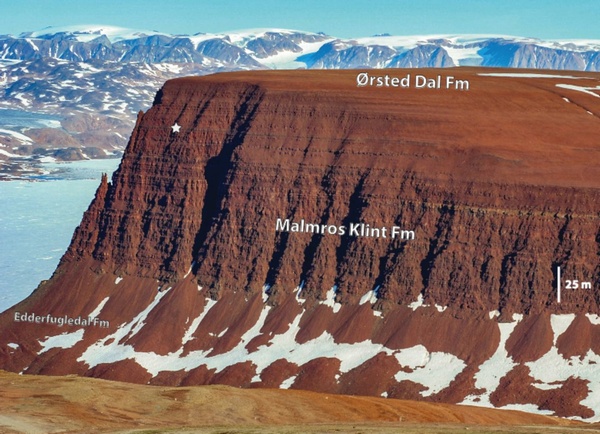Yet they didn't.Though sauropodomorph dinosaurs first appeared in Argentina and Brazil about 230 million years ago, it took them 15,000,000 years to migrate to the northern hemisphere.
"It's as if snails could have done it faster," says Dennis Kent, adjunct research scientist at Columbia University's Lamont-Doherty Earth Observatory and co-author of a new paper on sauropodomorphs -- a group of long-necked, herbivorous dinosaurs that eventually included Brontosaurus and Brachiosaurus. Even if a dinosaur herd walked only one mile per day, it would take less than 20 years to make the journey between South America and Greenland.
Instead, it took them 15,000,000, according to new results based on ancient magnetism patterns in rock layers at fossil sites across South America, Arizona, New Jersey, Europe and Greenland.

A cliff in Jameson Land Basin in central East Greenland, the northernmost site where sauropodomorph fossils are found. Image: Lars Clemmensen
The answer may be CO2; 215 million years ago, though the temperature was not drastically higher, CO2 levels were 1,000% of what they are today - 4,000 parts per million. Over the next 3,000,000 years, the CO2 concentration halved, to about 2,000ppm.
milder levels of CO2 may have helped to remove climatic barriers that may have trapped the sauropodomorphs in South America.
On Earth, areas around the equator are hot and humid, while adjacent areas in low latitudes tend to be very dry. Kent and Clemmensen say that on a planet supercharged with CO2, the differences between those climatic belts may have been extreme -- perhaps too extreme for the sauropodomorph dinosaurs to cross.
"We know that with higher CO2, the dry gets drier and the wet gets wetter," said Kent. 230 million years ago, the high CO2 conditions could have made the arid belts too dry to support the movements of large herbivores that need to eat a lot of vegetation to survive. The tropics, too, may have been locked into rainy, monsoon-like conditions that may not have been ideal for sauropodomorphs. There is little evidence they ventured forth from the temperate, mid-latitude habitats they were adapted to in Argentina and Brazil.
But when the CO2 levels dipped 215-212 million years ago, perhaps the tropical regions became more mild, and the arid regions became less dry. There may have been some passageways, such as along rivers and strings of lakes, that would have helped sustain the herbivores along the 6,500-mile journey to Greenland, where their fossils are now abundant. Back then, Greenland would have had a temperate climate similar to New York state's climate today, but with much milder winters, because there were no polar ice sheets at that time.
"Once they arrived in Greenland, it looked like they settled in,'" said Kent. "They hung around as a long fossil record after that."
The idea that a dip in CO2 could have helped these dinosaurs to overcome a climatic barrier is speculative but plausible, and it seems to be supported by the fossil record, said Kent. Sauropodomorph body fossils have not been found in the tropical and arid regions of this time period -- although their footprints do occasionally turn up -- suggesting they did not linger in those areas.





Comments